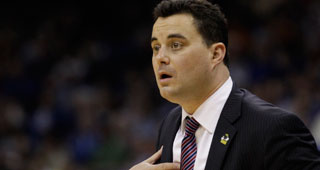Click Here for Page 1 of the Projections
Click Here for Page 2 of the Projections
|
Team |
PW |
PL |
P% |
FrP% |
T10Fr |
N100 |
Total |
NC |
RV |
MOV12 |
|
Ohio St. |
14 |
4 |
61% |
11% |
0 |
0 |
6 |
N |
0.989 |
0.964 |
|
Indiana |
13 |
5 |
83% |
22% |
0 |
3 |
6 |
N |
1.008 |
0.918 |
|
Wisconsin |
13 |
5 |
71% |
5% |
0 |
1 |
3 |
N |
0.981 |
0.942 |
|
Michigan St. |
12 |
6 |
59% |
22% |
0 |
4 |
9 |
N |
0.974 |
0.954 |
|
Michigan |
10 |
8 |
64% |
24% |
1 |
2 |
3 |
N |
0.974 |
0.854 |
|
Minnesota |
10 |
8 |
91% |
31% |
0 |
0 |
2 |
N |
1.002 |
0.797 |
|
Purdue |
8 |
10 |
44% |
12% |
0 |
2 |
3 |
N |
0.940 |
0.868 |
|
Illinois |
8 |
10 |
73% |
18% |
0 |
0 |
6 |
Y |
0.971 |
0.740 |
|
Iowa |
6 |
12 |
68% |
23% |
0 |
2 |
2 |
N |
0.996 |
0.704 |
|
Penn St. |
6 |
12 |
76% |
14% |
0 |
0 |
0 |
N |
1.028 |
0.590 |
|
Northwestern |
6 |
12 |
60% |
15% |
0 |
0 |
0 |
N |
0.974 |
0.747 |
|
Nebraska |
2 |
16 |
37% |
4% |
0 |
0 |
0 |
Y |
1.001 |
0.510 |
-I project that Jared Sullinger and Myers Leonard declare for the draft and that Cody Zeller and DeShaun Thomas return.
-If Zeller comes back, Indiana should compete for the league title.
-Personally, I might flip Wisconsin and Michigan St., but here is why the model lists them this way. Draymond Green was much more of a stat-sheet stuffer than Jordan Taylor and Wisconsin’s margin-of-victory numbers were better than their win-loss record last year. I don’t think the model recognizes how important Jordan Taylor was, in part because his defense isn’t measured like Draymond Green’s defensive rebounding, and in part because last year was not his best season.
-There is a reason that new Nebraska head coach Tim Miles was begging for some time to build the program in his opening press conference. He is going to need it.
Notes
The basic model incorporates several well-established basketball facts: First, experience matters. Teams that have more returning minutes (and possessions) tend to improve. Second, teams that return more efficient scorers (i.e. better shooting percentage, fewer turnovers) improve more than teams that return less efficient scorers. Third, the biggest leap in development is from a player’s freshman year to his sophomore year. Teams that give major minutes to freshmen tend to improve significantly the following season. Fourth, the return of injured players (such as Louisville’s Mike Marra) has a predictable impact on team performance. Fifth, for incoming transfers, the performance with the previous team provides some information about the player’s future performance. Sixth, coaching ability impacts performance in a predictable manner. And finally, high school recruits can have a significant impact on a team’s performance. High school recruits ranked in the Top 10 have the biggest impact, but players ranked in the Top 100 are also important. These factors are combined to produce a numeric ranking of teams for the upcoming college basketball season.
These projections remove all graduating seniors, announced transfers, and early entrants from rosters. My transfer information comes from Jeff Goodman’s transfer list and College Hoops Update. I include all transfers listed on April 1st, and all early entrants as of 4pm on April 2nd. Roster projections account for consensus Top 100 recruits as listed by RSCI, and incoming transfers.
-Continue to follow the news because a lot can still change this summer. Besides the fact that there will be more NBA draft early entry announcements, and more transfers, there are still 9 elite recruits who are uncommitted. There are also plenty of unusual situations that need to be resolved. Will Scott Martin or Tim Abromaitis be granted a 6th year of eligibility? Will Georgetown’s Tyler Adams be cleared to play despite his heart ailment? Who will fail to qualify academically? And who will get kicked off their team during the summer? Last year Mississippi St. recruit David Gardner got kicked off the team for obscene Tweets, so there will be plenty to update during the summer.



